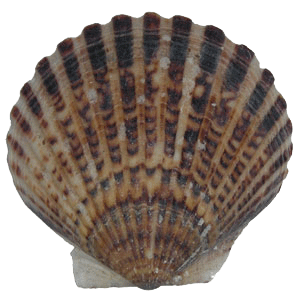| Shellfish - Bay Scallop |  |
Shellfish - Bay Scallop | | Argopecten irradians |
| Key Distinguishing Markings:
- Shell lightweight, thin, but strong.
- 13 to 22 symmetrically radial ribs originating from central point (umbo) of shell.
- The marginal wings or ears at the umbo are slightly different in size and shape.
- Bottom valve more convex than top valve.
- Color highly variable in this species:
- Top (left) valve – drab; dark grey, black, or brown; occasionally with yellow, orange, or red highlights; ribs sometimes mottled or concentrically banded.
- Bottom (right) valve – usually lighter in color than top valve, sometimes pale yellow or white.
| Distribution:
- Bay scallops are primarily found from Massachusetts to Texas.
- In Maryland, they only occur in the coastal bays behind Ocean City and Assateague Island.
| Size:
- Adults can grow as large as 90 mm (3 ½ in).
- Scallops reach sexual maturity at about 55 mm (2 ¼ in), although age actually determines this.
| Habitat:
- Bay scallops inhabit the higher salinity (>15-20 ppt) shallows of bays and estuaries along the coast.
- This species is intimately associated with eelgrass beds.
- When a blight wiped out the grass beds in the 1930's, scallop populations plummeted and completely disappeared in some areas.
- Young scallops attach to blades of eelgrass with thin byssal threads.
- By suspending themselves above the substrate, they are removed from suffocating silt and bottom-marauding predators such as crabs.
- Adult scallops live on the bottom, unlike many other bivalves such as clams which live buried in the sediment.
- Because scallops do not burrow into the bay bottom, adults only have a non-functional foot and do not have siphons.
- They can also be found occasionally on shelly areas such as the remnant oyster shell bars in Chincoteague Bay.
| Spawning:
- Scallops are hermaphrodites, simultaneously having both male and female sex organs.
- Spawning in Maryland occurs during May/June, with a second spawning in September.
- Eggs are released into the water column, where they are fertilized.
- During its spawning period, a one-year old scallop produces an average of 16 million eggs.
- The fertilized eggs develop into swimming larvae, complete with tiny shells.
- Water currents distribute the larvae around the estuary. Mortality is very high during this stage of their life history.
- After about 2 weeks, the larvae drop out of the water column and change into juvenile scallops, a process called metamorphosis.
- During metamorphosis, a foot and gills develop, the swimming organ disappears, and the tiny scallops attach to seagrasses or other objects.
- The foot, along with byssal threads, allows the juveniles to crawl up the grass blades.
- The juveniles will remain attached until they reach a size of 20 – 30 mm (¾ – 1 ¼ in), when they drop to the bottom.
- The foot fails to develop further, becoming a vestigial organ in the adults.
- This is a short-lived species, with a life span of only 12 to 26 months.
| Fishing Tips:
Scalloping Tips:
- Because of their extreme scarcity in our waters, any bay scallops caught should be returned to their environment.
- With conservation of the bay scallops and the seagrasses in which they live, hopefully their numbers will flourish.
- A mask and snorkel or a clear plexiglass-bottom bucket can be used to observe scallops in their natural habitat.
| Fun Fact:
- Unlike other species which are bound to some substrate either by burrowing or attachment, adult bay scallops are free-living and extremely motile.
- They are capable swimmers for short distances, which they accomplish by jetting water through their valves, generally in response to predators.
- Bay scallops have 18 pairs of blue eyes set in the mantle along the margin of the shell.
- The eyes can detect shadows and movement, which brings about an escape response.
- In an attempt to re-establish a population in Chincoteague Bay, MDNR Shellfish Program planted 1.2 million juvenile bay scallops in protective pens and raised them to reproductive age during1997 and 1998.
- By 2002, live scallops were recorded north of the Ocean City Inlet, possibly for the first time in well over a century.
- Although low densities suggest that the long-term viability of this scallop population is still in doubt, the extraordinarily rapid range expansion is a major step towards their establishment in Maryland.
Phylum: Mollusca
| | Family: Pectinidae | | Order: Ostreoida | | Class: Bivalvia | For more information on bay scallops, please contact Mitchell Tarnowski.
Photograph courtesy of Mitchell Tarnowski
|
|
